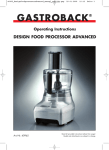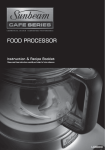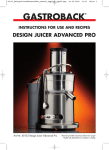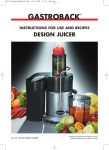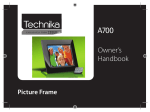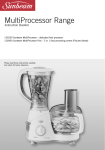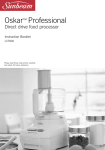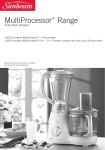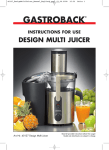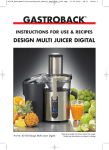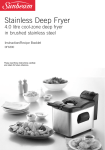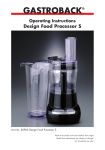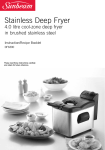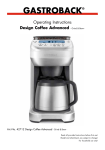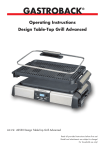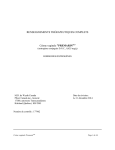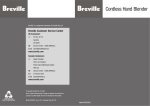Download Gastroback Design Food Processor Pro
Transcript
Operating Instructions Design Food Processor Pro Art.-No. 40964 Design Food Processor Pro Read all provided instructions before first usage! Model and attachments are subject to change! For household use only! Carefully read all provided instructions before you start running the appliance and pay regard to the warnings mentioned in these instructions. Table of Contents Knowing your Design Food Processor Pro.........................................41 Important safeguards......................................................................43 General safety instructions...........................................................43 Important safeguards for electrical appliances................................44 Moving parts – Risk of injuries.....................................................45 Technical specifications...................................................................46 Operation.....................................................................................46 Before first use...........................................................................47 Properties of the Design Food Processor Pro..................................47 Safety interlocks.........................................................................48 Modes of operation....................................................................48 Operating with the normal processing bowl...................................48 Mini processing bowl and small universal ´s´ blade........................51 Tips for preparing the food..............................................................52 Care and cleaning.........................................................................52 Disassembling the appliance........................................................53 Cleaning the appliance...............................................................53 Storage.........................................................................................54 Notes for disposal..........................................................................55 Information and service...................................................................56 Warranty......................................................................................56 Index............................................................................................57 Recipes.........................................................................................58 Dear customer! Congratulations! A variety of possibilities for delicious meals comes with your new Gastroback Design Food Processor Pro. Different sets of tools are designed to meet all your requirements for time-saving preparation of the ingredients for your dishes, salads, desserts, and drinks. Effortless and within seconds you prepare the ingredients for delicious meals. The Food Processor is intended for cutting and grating of fruits and vegetables, for mincing meat and chopping herbs, for beating cream and egg white, and for grinding, mixing, and emulsifying. These instructions for use will inform you about the various functions and features, which make it easy to take pleasure in your Food Processor. We hope that you will enjoy your Design Food Processor Pro. Your Gastroback GmbH Knowing your Design Food Processor Pro Pusher – for pushing the food down in the feed chute; including a scale for measuring small amounts of liquids, flour and similar foodstuffs Feed chute – here you add the prepared food Lid – is firmly closed during operation via a safety interlock Bowl– stands firmly on the motor base by means of the safety interlock Mini-Bowl – for processing small amounts, including separate bowl lid for storage of food Spindle – removable for easy cleaning ON/OFF button –switching on the motor for continuous operation; indicator is illuminated when switched ON PULSE button – the motor will run only as long as you press the button down; with indicator Motorbase – with non-slip rubber legs, standing fitmly and stable Storage drawer – for storing most of the cutting tools safely w/o figure: · Power cord · Safety interlocks – switch OFF the motor, when bowl and/or lid are not assembled and locked correctly 41 Accessories / Tools A: Variable slicing blade: The variable stainless steel slicing blade allows foods to be sliced to a variety of thickness up to 5 mm - for fine and coarse vegetable slices. A B B: Reversible grating and shaving disc: Unique to processing is the shaving blade. It does lovely thin flakes, great for parmesan and sweet potato crisps. The other side will achieve finely grated results, ideal for hard cheeses and chocolate. C: Reversible shredding disc - fine and coarse: Ideal control, the reversible stainless steel shredding blades allow for the choice of fine or coarse results. D: Emulsifying disc - for beating, mixing and emulsifying liquids. E: Universal ‘s’ blade: Stainless steel smooth edged processing blade is designed for cutting, kneading, whisking and emulsifying. C D E F/G: Additional mini processing bowl with small universal ‘s’ blade and lid - for cutting and kneading small portions and for storage. F G H H: Spatula: The spatula is ideal for assisting with all food processing tasks. 42 Important safeguards Carefully read all instructions before operating this appliance and save for further reference. Do not attempt to use this appliance for any other than the intended use, described in these instructions. Any other use, especially misuse, can cause severe injuries or damage by electric shock, moving parts, heat or fire. These instructions are an essential part of the appliance. Do not pass the appliance without this booklet to third parties. Any operation, repair and technical maintenance of the appliance or any part of it other than described in these instructions may only be performed at an authorised service centre. Please contact your vendor. General safety instructions •This appliance is for household use only and NOT intended for use in moving vehicles. Do not operate or store the appliance in humid or wet areas or outdoors. Any use of accessories, attachments or spare parts that are not recommended by the manufacturer or damaged in any way may result in damage and/or injuries to persons. •Check the entire appliance regularly for proper operation – especially the power cord. Do not operate the appliance, when the appliance or any part of it is likely to be damaged, to avoid risk of fire, electric shock or any other damage and/or injuries to persons. The appliance is likely to be damaged if the appliance has been subject to inadmissible strain (e.g. overheating, mechanical or electric shock), or if there are any cracks, excessively frayed or melted parts, or distortions, or if the appliance is not working properly. In this case, immediately unplug the appliance and return the entire appliance (including all parts and accessories) to an authorised service centre for examination and repair. •Operate the appliance on a well accessible, stable, level, dry, water-resistant, and suitable large table or counter. Always keep the appliance and the table or counter clean and dry, and wipe off spilled liquids immediately. Always remove the bowl from the motor base, before taking food out of the bowl. Do not place any clothes or tissue or other objects under or on the motor base during operation, to avoid risk of fire, electric shock and overheating. Do not place the appliance over a power cord, or near the edge of the table or counter, or on wet or inclined surfaces, or where it can fall. •During operation keep the appliance in an appropriate distance of at least 20 cm on each side and 50 cm above to furniture, walls, boards, curtains, and any delicate objects. Exclusively use the appliance for processing edible food and domestic use. Immediately unplug the appliance, if there is any kind of malfunction or problem (e.g. the motor gets stuck, liquid running out, overheating). Do not needlessly operate the appliance continuously. Always switch OFF the motor even when making short brakes (e.g. for preparing further ingredients). •This appliance is NOT intended for use by persons (including children) with reduced physical, sensory or mental capabilities, or lack of experience and knowledge, unless they have been given supervision or instruction concerning use of the appliance by a person responsible for their safety. Children must be supervised to ensure that they do not play with the appliance or any parts of the appliance or the packaging. Always keep the appliance where it is dry, frost-free, and clean, and where young children cannot reach it. Do not leave the appliance or any part of it unattended, when it is in reach of young children. 43 •Do not place the appliance or any part of it on or near hot surfaces (e.g. burner, heater or oven). Do not use any parts or tools of the appliance with any other device or for any other purpose. •Before operation, always ensure that the appliance is assembled completely and correctly according to the instructions in this booklet. Do not use violence. •Do not insert your fingers or any foreign objects (e.g. clothes, cooking utensils) in the feed chute, with the appliance connected to the power supply. Do not use any hard, sharp or edged objects (e.g. knives, forks) with the appliance. Only use the provided pusher for feeding food into the feed chute. Do not handle the appliance or any part of it with violence. •Always use only one matching set of tools according to the instructions in this booklet to avoid damage. Do not process bones, nutshells or any other extremely hard items. •Do not overfill the bowl. If the maximum filling level is reached, empty the bowl, before continuing processing your food. When processing liquids, do not fill in more than up to filling level 500 ml. Otherwise, liquids could run out from under the lid. If liquids run out or are spilled on the motor base, immediately unplug the appliance. •Do not leave the appliance unattended, when it is connected to the power supply. Always switch OFF (ON/OFF button; indicator goes out) at first, then unplug the appliance, and wait until the motor comes to a standstill, before moving, or cleaning the appliance, or assembling or disassembling any parts, or when the appliance is not in use. Always grasp the motor base at both sides near the bottom for moving or lifting. Do not hold the appliance at the bowl, lid, or power cord for moving the appliance. Do not place any hard and/or heavy objects on the appliance or any part of it. Take care that no one will pull the appliance by the power cord. •Do not use any abrasive cleaners, cleaning pads (e.g. metal scouring pads), or any corrosive chemicals (e.g. bleach) for cleaning. Do not immerse the motor base or power cord in water or any other liquid. Do not spill or drip any liquids on the motor base, or on the power cord to avoid risk of fire and electric shock. •Do not place the motor base or power cord in an automatic dishwasher. •Do not leave any food dry on the appliance. Always clean the appliance after each use to prevent a build up of baked-on foods (see Care and Cleaning). Always keep the appliance and the tools clean. Important safeguards for electrical appliances The appliance is driven electrically. Place the appliance near a suitable wall power socket to connect the appliance directly to a protected mains power supply with protective conductor (earth/ground) connected properly. Ensure that the voltage rating of your mains power supply corresponds to the voltage requirements of the appliance (230 V, 50 Hz, AC, rated for at least 8 A). The installation of a residual current operated circuit breaker (r.c.c.b.) with a maximum rated residual operating current of 30 mA in the supplying electrical circuit is strongly recommended. If in doubt, contact your electrician for further information. In various foreign countries, the specifications for power supplies are subject to incompatible norms. Therefore it is possible that power supplies in foreign countries do not meat the requi44 rements for safe operation of the appliance. Thus, before operating the appliance abroad, ensure that safe operation is possible. •Do not to use any extension cords or desk top multi socket outlets. •Always handle power cords with care. Always completely unwind the power cord before use. Do not place the appliance on a power cord. Power cords may never be knotted, twisted, pulled, strained or squeezed. Do not let the plug or power cord hang over the edge of the table or counter. The power cord may not touch hot surfaces or sharp edges. Ensure that no one will pull the appliance by the power cord. Take care not to entangle in the power cord. Always grasp the plug to disconnect the power cord. Do not touch the power plug with wet hands when the appliance is connected to the power supply. •When liquids are spilled on the motor base or power cord, immediately unplug the appliance. Thereafter, clean the appliance and let it dry for at least 1 day. See: Care and Cleaning Moving parts — Risks of injuries The appliance is intended for cutting, chopping and mixing food. Thus, moving/cutting parts of the appliance can cause severe injuries, when used contrary to these instructions. •Do not insert your hands, hair, clothes, brushes, or other foreign objects (e.g. bones, stalks of vegetables, cooking utensils) in the feed chute of the appliance, when the appliance is connected to the power supply. Only use the provided pusher to push down the ingredients. Do not push with violence, to avoid that the motor gets blocked. •The blades of the tools are very sharp. Handle with care! Only touch the cutting tools at the black plastic parts to avoid injuries. Do not attempt to use more than one set of cutting tools simultaneously, unless it is described in the instructions in this booklet this way. •Do not hold your face over the feed chute, while the motor is agitating, because food and liquids could splash through the feed chute. Moreover, splinters could escape from the feed chute, if you failed to see small pieces of bones or other hard parts (e.g. shells, stones) while preparing the foods. DO NOT push the foods with your hands down in the feed chute, or poke in the feed chute! •Always assemble the appliance according to the instructions in this booklet completely and correctly, before connecting the appliance to the power supply. Doing so, be aware, that the motor will start IMMEDIATELY, if the ON/OFF button is set to ON at this moment. Thus, always ensure that the appliance is always ready for working, before connecting to the power supply. Always switch OFF (indicator in the ON/OFF button goes out) the appliance via the ON/OFF button first, when setting it out of operation. This holds also, when the motor suddenly stops agitating due to overheating or braking of a safety interlock. 45 Technical specifications Model: Art. No. 40964 Design Food Processor Pro Power supply: 230-240 V AC, 50 Hz Power consumption: 650 - 700 W Length of power cord: ca. 1 m Weight: ca. 5.5 kg Dimensions: ca. 21.0 cm x 28.0 cm x 39.5 cm (width x depth x height) Maximum filling level: 1.5 Litre Certification: Operation WARNING: The appliance is intended for cutting and mixing food. For this, the appliance is equipped with sharp knives and other electrically driven moving parts. DO NOT insert your hands or any foreign objects (e.g. cooking utensils, clothes) in the feed chute, when the appliance is connected to the power supply, to avoid risks of injuries and damage. Only use the provided pusher for pushing food down in the feed chute. Always switch OFF the ON/OFF button (indicator goes out) first, then unplug the appliance, before assembling or disassembling any parts. Before operation, always ensure that you have assembled the appliance completely and correctly according to the instructions in this booklet, and that there are no foreign objects in the feed chute. Carefully remove hard, inedible parts of your foods (e.g. bones, seeds, stalks, wooden shells) completely, before processing. Do not place clothes, tissues or any other foreign objects on or under the appliance during operation. Do not place the appliance over a power cord. Do not use any hard or sharpedged objects (e.g. forks, knives), to avoid damage to the appliance. Do not use violence! If liquids come out from under the lid, run down the exterior of the appliance and/or accumulate under the appliance, immediately unplug the appliance to avoid injuries and damage by electric shock. Always wipe off spilled liquids immediately. Do not overfill the bowl. Always observe the maximum amount, given for the individual toolsets. If necessary, empty the bowl regularly. If liquids accumulate again under the appliance, possibly the bowl is leaking. 46 Before first use WARNING: DO NOT let young children play with the appliance, or any part of it, or the packaging! The cutting tools are very sharp. Ensure not to get injured when unpacking the tools. The length of the power cord is about 1 m. Do not attempt to pull out the power cord any further than this. 1.Unpack the appliance and all accessories carefully. 2.Some cutting blades are placed in the drawer in the motor base. Pull out the drawer and avoid cutting yourself, when taking out the tools. Thus, always grasp the tools only at the black plastic parts. 3.Probably, the power cord is inserted in the back of the motor base. Carefully, pull out the power cord without using violence. The power cord is about 1 m in length. Do not attempt to pull out the power cord any further than this. 4.Check that no parts are damaged or missing. See: Knowing Your Design Food Processor Pro 5.Carefully remove all shipping materials and promotional materials, but DO NOT remove any warning labels or the model label. Especially ensure that there are no foreign objects (e.g. packaging) in the interior of the bowl. WARNING! Always switch OFF (ON/OFF button; indicator goes out) and unplug the appliance, before cleaning. Do not immerse the motor base or power cord in water or other liquids or spill any liquids on the motor base or power cord. Do not place the motor base or power cord in an automatic dishwasher. 6.Before first use and after a longer period of storage, clean the appliance and all tools. (See: Care and Cleaning) Properties of your Design Food Processor Pro Your Food Processor processes your food in only a few seconds. For most purposes there is no need to continuously operate the appliance for more than a few minutes. Even heavy dough (e.g. yeast dough) is processed in 2 or 3 minutes (at the maximum). Also when using a cutting blade and adding your food via the feed chute, you should switch off the motor for filling the feed chute anew. This way you get better results. Additionally, you should not press too violently on the pusher, when processing your food. See: Safety interlocks If you wish to process your food for a elongated time (e.g. mixing dough using the chopping blades), always make brakes in between times, switching the motor OFF to avoid overheating. The appliance is NOT suited for grinding very hard parts of foods (e.g. stones, woody shells, bones). 47 Safety Interlocks WARNING: Do not attempt to damage or by-pass the safety interlocks! Your new Design Food Processor Pro is equipped with various safety features for your protection. •Safety interlocks switch OFF the motor, if the bowl or the lid is not assembled and locked correctly, to avoid injuries due to the cutting blades and other moving parts. •The automatic brake stops the motor almost immediately, as soon as the appliance is switched OFF. •The appliance is provided with a safety thermal cut-out device and will shut off, when overloaded. If the appliance suddenly stops during operation, immediately switch OFF (indicator goes out) and unplug. Then wait for about 15 minutes to let the motor cool down. Thereafter, you can operate the appliance quite as usual. (See: „Operation“) However, to avoid that overheating occurs again, you should repeatedly make brakes during working—depending on the load (e.g. for kneading heavy dough). •The motor base is mounted on rubber legs, ensuring a stable, non-slip stand on smooth surfaces (e.g. glass, metal, painted surfaces). •For storage you can place the cutting tools in the bowl and in a drawer in the motor base, thus avoiding injuries. Additionally, this way the tools are always at hand. (See: „Storage“) Modes of operation The appliance can be operated in two operating modes: continuously and pulse. •Press the ON/OFF button for continuous operation. An indicator in the ON/OFF button is illuminated, if the appliance is switched on. If the indicator is illuminated but the motor does not work, first press the ON/OFF button to switch OFF the appliance (indicator goes out), then check, if you assembled the appliance completely and correctly. (See: Operation) Thereafter try again. •Alternatively, you can operate the motor in short pulses using the PULSE button for a better control of the consistency of your food. This function is most useful, when using the chopping blades for mincing and puréeing, or for beating and mixing using the emulsifying disc. Even when using a cutting disc, you should prefer this operating mode for better results. Operating with the normal processing bowl WARNING: Always turn the appliance ´OFF`, wait until the motor stops and unplug the appliance before assembling/disassembling. Always completely assemble your appliance before you plug the plug into the power outlet and ensure no foreign substance is in the feed chute. Only touch the discs on the edge and blades by its central plastic section and handle with care when cleaning. 48 1. Place the motor base on a suitable, stable, dry, and clean working surface. (see: ‘Safeguards for Daily Operation’). The control panel has to face the front. 2. Place the bowl on the motorbase turning it anticlockwise until it is securely locked in position. Do not use any force. The handle should be facing the front which is above the control panel. 3. Fit the spindle onto the drive shaft, in the middle of the processing bowl. The long shaft of the spindle has to slide over the drive shaft and the end with the aglet should face upright. If necessary turn the spindle a little to fit in position. The spindle sticks out of the bowl for 1 or 2 cm. Note: All attachments must be firmly attached to the spindle. Always adjust the attachments until you are sure that they are correctly fitted. 4. Put the disc or blade you want to use on top of the spindle turning the disc until the hexagonal nut of the disc fits on the hexagon bolt of the spindle. The side which you want to use has to face upwards. Operating the different discs and blade Reversible grating and shaving disc For grating (i. e. carrots) use the grating and shaving disc. To achieve finely grated results, the side with the arched blades has to face upwards. To achieve finely grated flakes the side with the small blades has to face upwards. Reversible shredding disc - fine and coarse To achieve fine and coarse shredding results use the shredding disc (i.e. cucumber) and put it onto the top of the spindle. For coarse shredding results, the side with the bigger arched blades has to face upwards. For fine shredding results, the side with the smaller arched blades has to face upwards. Variable slicing blade It allows foods to be sliced to a variety of thickness up to 5 mm. To adjust the blade you have to turn the shaft which is located on the bottom side of the disc. For thinner slices turn the shaft clockwise and for thicker slices turn the shaft counterclockwise. shaft to adjust the thickness of the slices Note: There are two holes in the disc to ease disassembling. Put your fingers through the holes and slightly pull the disc upwards to remove it. Pay attention not to cut yourself. Emulsifying disc Use this disc for whisking, mixing, and emulsifying of liquids. It serves for mixing drinks, beating creme and egg white, and preparing mayonnaise. Ensure to insert the emulsifying disc with the shaft facing upwards! 49 Universal ‘s’ blade For cutting vegetables, fish or meat, kneading batter or making shakes, soups or ice cream use the universal ‘s’ blade. Warning: Use caution, as blades are sharp. Always handle the processing blade by its central plastic section. Fit the universal ‚s‘ blade onto the spindle and press firmly into place. Ensure the blade is securely locked on the spindle. The blade is correct assembled if the central plastic section faces upwards and flushes with the wider part of the spindle. The blade is placed a few millimetres above the bottom of the processing bowl. 5. Position the lid onto the processing bowl. You will notice a solid grey arrow to the left of the holding lip on the lid, when placing the lid onto the bowl this arrow needs to align with the solid grey arrow on the handle of the bowl. To lock, turn the lid clockwise. The lid has four guiding pins which have to fit into the cannelure of the processing bowl in order to lock the lid. Turn the lid clockwise and push up against. The lid is securely locked in position if the arrow on the handle is facing the line on the lid. Note: If the processing bowl and cover are not correctly assembled, the Food Processor will not operate. This is a safety feature. 6. Prepare your food and fill it in the processing bowl. If necessary cut the food in proper size to fit through the feed chute. guiding pins cannalure 7. Note: For maximum control when using your food processor, before turning on your food processor load the feed chute and fit the food pusher on top. WARNING: Do not push products into the feed chute with your fingers or foreign objects. Always use the food pusher provided. While proceeding do not push the food pusher too hard down. To refill the feed chute always remove the food pusher first. 8. Connect the power plug to a suitable wall power outlet. 9. Start the appliance pressing the ´ON` button. The motor starts working, the food is getting processed and gathered at the base of the bowl. While proceeding do not push the food pusher too hard down to avoid overloading the motor. If the motor stalls or stucks during operation or if the fibre of the food blocks the blade, immediately turn ´OFF` the appliance and unplug the power cord. Check whether there is any obstruction in the processing bowl, and remove it (see „Care and Cleaning“). ATTENTION: Do not use the appliance in continuous operation for more than 4 minutes to avoid overheating. If processing large quantities of food, regularly interrupt operation and unplug the appliance for at least 1 minute, to let the motor cool down. Important: The Food Processor is fitted with a safety thermal cut-out device and will shut off in the event of overload. If this occurs, switch the appliance off and it will automatically reset when cool. 10. You can continue to fill the feed chute as soon as the feed chute is empty. ATTENTION: Never hold your face or other body parts over the feed chute when the motor is running because little pieces of food could be thrown out of the feed chute. 50 WARNING: Do not overfill the processing bowl. Possibly, take some food out of the processing bowl, using a wooden or plastic spoon, before starting the appliance again. Note: Very stringily food can block the blades. In this case turn the appliance off, wait for the disc to stop moving and remove the plug from the power outlet. Take off the lid by turning it counterclockwise. Remove the disc. Rinse the disc thoroughly under running water and remove food residues. Assemble the appliance and continue to operate. 11. As soon as the food has the right consistency turn the appliance ´OFF`. Always turn the appliance ´OFF` and pull the plug when the appliance is not in use and you finished the operation. 12. Empty the bowl. Clean the appliance in accordance to the instructions in chapter „Care and Cleaning“. Do not leave any food dry on the surfaces of the appliance. Mini processing bowl and small universal ‘s’ blade Processing small amount of vegetables, herbs, fish or meat use the mini processing bowl and the small universal ‘s’ blade. Act according to the instructions ´Operating with the normal processing bowl` including point 3. Take the mini processing bowl and place it above the spindle inside the processing bowl. Fit the universal S‘ blade onto the spindle. Note: You can use the small universal ‘s’ blade only when processing inside the mini processing bowl. The big universal ‘s’ blade as well as the discs do not fit into the mini processing bowl. ATTENTION: Use caution, as blades are sharp. Always handle the processing blade by its central plastic section. Fit the universal ‚s‘ blade over the spindle and press firmly into place. Ensure the blade is securely locked on the spindle. The blade is correct assembled if the central plastic section faces upwards and flushes with the wider part of the spindle. Only the little metal centre of the spindle protrudes about 7 mm. The blade is placed a few millimetres above the bottom of the mini processing bowl. Proceed with step 5 of the instructions „Operating with the normal processing bowl“. Note: The mini processing bowl has a lid for storing the processed food. Ensure to take the blade out of the mini processing bowl before closing the lid and storing the food inside the bowl. 51 Tips for preparing the food • Remove uneatable and hard parts of the food: stalks, skins and shells, seeds, bones, gristle, and tendons. Peal tomatoes before processing. • Using the universal ‚s‘ blade: pre-cut meat, cheese, onions and frozen food into cubes approximately 2 cm square and place them into the processing bowl. More consistent processing results are achieved if the bowl is not overloaded (fill the bowl only half-full). • For the best, most consistent results, you should try to process pieces of food that are approximately equal in size. • Dry herbs before processing. Otherwise the ingredients could go lumpy. Use the universal ‚s‘ blade for chopping herbs and leafy vegetables. • Processing nuts, fresh herbs, leafy vegetables or food alike, use the pulse button. The motor is only running as long as you hold the button down. Releasing the button the motor turns ´OFF` automatically. Press the button as often as needed. • Remember that softer foods such as cheese (cheddar, mozzarella or swiss) should be well chilled before processing. Harder foods such as parmesan or Romano cheese should be at room temperature before processing. Note: When grating parmesan cheese do not apply a lot of pressure to the food pusher. • When processing vegetable or fruit cut the food in size to fit the feed chute. Cut cucumber and zucchini lengthwise for example. • Place carrots and simular roots tip facing down in the feed chute. • The feed chute should always be packed firmly to allow each piece of food to support the others. There will always be a small portion of food left unprocessed between the food pusher and the blade. • Preparing longer slices: Pack food items horizontally in the feed chute,. • Do not overload the food processing bowl. The normal processing bowl has a max capacity of 2 litres. The mini processing bowl should not be more then half-full and using the food collector the load should not be higher then 5 cm underneath the edge. Use smaller portions rather then overloading the food processor. • When processing sauces or semi-liquid ingredients, stop the food processor and scrape down the bowl sides with the spatula provided. Pull the plug out of the power outlet and do not insert your finger into the processing bowl. • Do not overprocess the food. Care and cleaning WARNING: Always switch OFF the appliance (indicator goes out), and then unplug the appliance, before assembling or disassembling any parts, or moving or cleaning the appliance. Do not insert your hands or any foreign objects in the feed chute, with the appliance assembled and connected to the power supply. Do not leave any food dry up on the appliance or any parts of it to prevent a build up of dried-on foods. Always clean the appliance after each use according to the following instructions. 52 Disassembling the appliance WARNING: The blades of the cutting tools are very sharp. Handle with care! Always ensure that the appliance and any parts of it are out of reach of young children. Do not use violence! Bowl and lid are locked on the motor base for operation. Thus you must unlock these parts by turning them counter-clockwise before you can remove them. Additionally, the large chopping blades and emulsifying disc are firmly locked for operation via nozzles on the spindle. Remainder of food and liquids could drop from the parts of the appliance, when disassembling. Ensure that no liquids drip on the motor base, or any other delicate objects. Always remove the bowl from the motor base first, and place it on a stable and water-resistant surface, before opening the lid. 1.Switch OFF the ON/OFF switch (indicator goes out), wait until the motor comes to complete standstill, and unplug the appliance from power outlet. 2.Remove the pusher. CAUTION: Ensure that you do not spill the contents of the bowl, when removing it from the motor base. Keep the bowl level. 3.Grasp the bowl at its handle and turn it counter-clockwise as far as it goes to release the safety interlock. Then, keeping the bowl level, lift it from the motor base. 4.Place the bowl on a level, stable and water-resistant surface. 5.Turn the lid counter-clockwise as far as it goes to release the safety interlock. Then lift the lid from the bowl. WARNING: Do not touch the blades of the cutting tools. Only touch the cutting tools at the black plastic parts. Do not use any hard or sharp-edged object with the appliance to avoid damage to the surfaces. 6.Lift the tools out of the bowl: maybe small chopping blades and bowl, or cutting disc, spindle, perhaps assembled with chopping blades or emulsifying disc. 7. Empty the bowl. For this, you can use a plastic or wooden spoon or the provided spatula. 8. If you used the emulsifying disc or chopping blades, remove these tools from the spindle. However, do not use violence! These tools are locked on the spindle via two notches. Grasp the tool at the central plastic body. Then, using forefinger and thumb, push in the two notches on the spindle and simultaneously slip the tool over the notches. Thereafter, you can separate spindle and tool completely. 9.Clean all used parts and accessories, as described below. Cleaning the appliance WARNING: The blades of the cutting tools are very sharp. Handle with care to avoid injuries. Do not use any abrasive cleaners, cleaning pads (e.g. metal scouring pads), or any corrosive chemicals (e.g. bleach) for cleaning the appliance or any parts of it, to avoid damage to the surfaces. Do not immerse the motor base or power cord in water or any other liquid. Do 53 not spill or drip any liquids on the motor base, or on the power cord to avoid risk of fire and electric shock. Do not use violence! Dishwasher use Do not place the motor base or power cord in an automatic dishwasher. All plastic components deteriorate through prolonged use of a dishwasher for cleaning (e.g. discolouration, cracks, distortions). Nevertheless, all removable parts and accessories (bowl, lid, spindle, and tools) of your Food Processor are tolerant to dishwasher use. However, if using the dishwasher, place the parts only on the top rack. If your dishwasher features temperature control, do not select more than 65 °C (150 °F). Nevertheless, to extend the working life of the parts of your Food Processor, it is better to manually clean them in warm dishwater. Manual cleaning 1. Clean all removable parts (pusher, lid, tools, spindle, small bowl, spatula, bowl) with warm dish-water and a soft nylon brush. Doing so, ensure not to get injured by the cutting tools. Stubborn residues on the surfaces can be removed better by soaking in warm dishwater for some minutes. 2.Moisture a clean cloth or soft sponge with a little warm dishwater and carefully wipe the exterior of the appliance and the power cord. WARNING: Always ensure that the appliance and all parts of it are out of reach of young children. 3.Thoroughly dry the motor base and all parts, and let dry naturally for about half an hour out of reach of young children. If liquids dripped on the motor base, then let the appliance dry for at least 1 day. Storage WARNING: Always switch OFF (ON/OFF button indicator goes out), unplug and clean the appliance and all its parts before storing. (See: Care and Cleaning). The cutting tools are very sharp. Always ensure that no one can get injured by touching the blades unintentionally. Ensure to store the appliance where it is clean, dry and safe from frost, direct sunlight and inadmissible strain (mechanical or electric shock, heat, moisture) and where it is out of reach of young children. Place the appliance on a clean and stable surface, where it can not fall. Do not place any hard or heavy objects on the appliance or any part of it. Always handle the power cord with care. Power cords may never be knotted, twisted, or squeezed. Do not use any parts or tools of the appliance for any other purpose than operating the appliance. It is good advice to store the parts and accessories of the appliance with the appliance. For this, at least the cutting tools can be stored safely within the appliance or its accessories. 1.Always switch OFF, unplug, and clean the appliance and its parts before storage. (See: „Care and Cleaning“) 2. It is good advice to re-assemble the bowl on the motor base for storage. (See: Preparing 54 the Appliance) Additionally, you can store most of the parts and tools within the appliance. This way, you avoid injuries and damage by the tools and the parts can not get lost. Place the bowl on the motor base. For storage, it is quite sufficient to lock the bowl only until it engages firmly on the motor base and will not fall. This way, you avoid excessive wear to the safety interlocks. Insert the spindle in the bowl and put the emulsifying disc on it. Insert the small bowl. Insert the small chopping blade in the designated plastics cover, then insert it in the small bowl. Place the lid on the bowl. Again, the lid is already firmly in place without locking the safety interlock completely. Put the pusher into the feed chute. 3.Unique drawer design enables attachments such as the reversible shredding disc, reversible grating and shaving disc and the spatula to be stored conveniently within the appliance when not in use. Slide out the storage drawer at the base of the food processor. Place spatula on bottom of storage drawer. Place the universal blade in the storage drawer. Place one of the shredding disc in the storage drawer. Place the grating disc in on top of the shredding disc and close the drawer. Carefully push the drawer back into the motor base. CAUTION: Do not grasp the appliance by the bowl, power cord or lid for moving the appliance. To move the appliance, always grasp the motor base at both sides near the bottom. 4.Grasp the motor base with both hands at its sides, and place it on a suitable surface, where it can not fall, and is out of reach of young children. 5. Turn the adjusting screw of the variable slicing blade counterclockwise to the stop. This way, the blade is almost level with the plastic body of the disc, thus reducing the risk of injuries. 6.It is best to store emulsifying disc, the variable slicing blade, the small blade and the lid of the small bowl near the appliance. 7.Wind the power cord loosely around the motor base. Notes for disposal Dispose of the appliance and packaging must be effected in accordance with the corresponding local regulations and requirements for electrical appliances and packaging. Please contact your local disposal company. 55 Information and service Please check www.gastroback.de for further information. For technical support, please contact Gastroback Customer Care Center by phone: +49 (0)4165/22 25-0 or e-mail [email protected]. Warranty We guarantee that all our products are free of defects at the time of purchase. Any demonstrable manufacturing or material defects will be to the exclusion of any further claim and within warranty limits of the law free of charge repaired or substituted. There is no warranty claim of the purchaser if the damage or defect of the appliance is caused by inappropriate treatment, over loading or installation mistakes. The warranty claim expires if there is any technical interference of a third party without an written agreement. The purchaser has to present the sales slip in assertion-of-claim and has to bear all charges of costs and risk of the transport. 56 Index accessories.............................................................................................42 assembling........................................................................................... 48ff bowl....................................................................................41, 42, 48, 51 buttons...................................................................................................41 care and cleaning................................................................................. 52ff disassemble............................................................................................53 discs and blades.........................................................................42, 45, 49 dishwasher use.................................................................................44, 54 disposal.................................................................................................55 emulsifying disc................................................................................42, 49 extension cord........................................................................................45 feed tube.........................................................................................41, 44 filling level.......................................................................................44, 52 first use..................................................................................................47 grating and shaving disc....................................................................42, 49 intended use.....................................................................................41, 43 lid...................................................................................................41, 50 liquids...................................................................................................47 mini processing bowl.........................................................................42, 51 moving parts..........................................................................................45 operating components.......................................................................41, 43 operation...............................................................................................46 overheat protection...........................................................................48, 50 power cord......................................................................................41, 44 power supply....................................................................................44, 46 preparation.................................................................................... 52, 58ff properties..............................................................................................47 pusher...................................................................................................41 recipes..................................................................................................58 safety..............................................................................................43, 48 service...................................................................................................56 shredding disc..................................................................................42, 49 small amounts.........................................................................................51 spindle......................................................................................41, 49, 53 storage..................................................................................................54 storage drawer...........................................................................41, 47, 55 technical specifications............................................................................46 test for proper operation..........................................................................43 tips..................................................................................................52, 58 tools........................................................................................ 42, 49, 53ff universal ‘s’ blade.......................................................................42, 50, 51 variable slicing blade........................................................................42, 49 warranty................................................................................................56 workspace.............................................................................................43 57 Recipes Tips operating the universal ‘s’ blade FOOD AMOUNT COMMENTS BABY FOOD Up to 4 cups Add up to 4 cups cooked vegetables and meat to bowl, along with 1/2 cup cooking liquid/broth. Process to reach desired fineness. BREAD CRUMBS Up to10 slices Break either fresh or dry bread slices into quarters. Add to bowl and process until finely crumbed. COOKIE/CRACKER CRUMBS Up to 5 cups Use for crumbing graham crackers, chocolate or vanilla wafers. Break larger crackers into quarters. Add to bowl and process until fine. CRANBERRIES MINCED 3 cups Pulse to chop to desired fineness. Can also add sugar to make cranberry relish. EGGS, CHOPPED Up to 3 cups Peel, dry and halve hard-cooked eggs. Add to bowl. Pulse to chop, checking fineness after 4-5 pulses. GARLIC, MINCED Up to 5 cups Drop clove(s) down food chute while unit is running. MEAT (RAW OR COOKED) Up to 2 cups Cut meat into 1”(2.54 cm) cubes. Add to bowl and pulse to chop. MUSHROOMS,CHOPPED Up to 20 medium Halve large ones and add to bowl. Chop to desired fineness. NUTS, CHOPPED 2 cups Add to bowl and process to chop. ONIONS, CHOPPED Up to 3 large Quarter, and to bowl. Pulse or 2 times to coarsely chop. For green onions, cut into 1”(2.51 cm) pieces and add up to 3 cups. PARMESAN OR ROMANO CHEESE, GRATED Up to 1-1/2 cups Allow cheese to reach room temperature. Cut into 1”(2.54 cm) cubes. Add to bowl and process to desired fineness. PARSLEY, CHOPPED Up to 2 cups Add to bowl and Pulse to chop to desired fineness, abort 10-15 seconds Process other herbs in same manner (basil, cilantro, mint). PEPPER, GREEN, CHOPPED Up to 1 pepper Cut into 1”(2.54 cm) pieces. Add to bowl and pulse to chop. SOUPS, PUREED OR CREAMED 2 cups Add up to 2 cups hot(not boiling) vegetable soup for pureeing and creaming. Process to desired smoothness. SQUASH (BUTTERNUT) MASHED Up to 5 cups, 1”(2.54cm) cubes Add up to 8 cup cooked, drained squash to bowl. Process to puree. Works for pumpkin and sweet potatoes, also. STRAWBERRIES, PUREED 2 cups Hull and halve large berries. Add to bowl and process to chop. TOMATOES, CHOPPED 4 medium Quarter tomatoes. Add up to 4 and pulse to desired fineness. 58 Shredding guide FOOD COMMENTS CABBAGE Use fine shredding disc for very fine cabbage or slaw. Cut into pieces to fit chute. Shred using light pressure. Empty bowl as cabbage reaches disc. CARROTS Position in chute and shred. CHEESE, CHEDDAR Cut to fit chute. Cheese must be well chilled. CHEESE, MOZZARELLA Cut to fit chute. Cheese must be chilled in freezer for 30 minutes prior to shredding. Use light pressure. POTATOES Position in chute. Cut large potatoes in half or quarters. ZUCCHINI Cut to fit chute, either lengthwise or horizontally. Slicing guide FOOD COMMENTS APPLE Quarter and stack horizontally in chute. Use firm pressure. CABBAGE For coarsely shredded results, use slicing side of disc. Cut into pieces to fit chute. Empty bowl as cabbage reaches disc. CARROTS Cut into 4”(10.2cm) lengths and pack in chute, alternating thick and thin ends. CELERY Remove string. Cut stalks into thirds. Pack chute for best results. CUCUMBER Cut to fit chute if necessary. MUSHROOMS Stack chute with mushrooms on their sides for lengthwise slices. NUTS For coarsely chopped results, fill chute with nuts and slice. ONIONS Quarter and fill chute, positioning onions upright for coarsely chopped results. PEACHES/PEARS Halve or quarter and core. Position upright in chute and slice using light pressure. PEPPERS, GREEN Halve and seed. Fit pepper up bottom of chute, squeezing slightly to fit if necessary. Cut large ones into quarters or strips, depending on desired results. Slice using moderate pressure. PEPPERONI Cut into3”(8cm) lengths. Remove inedible casing. Slice 2 pieces at a time using firm pressure. POTATOES Peel if desired. Position in chute, cutting large potatoes in halves or thirds. STRAWBERRIES Hull. Arrange berries on their sides for lengthwise slices. TOMATOES Use small tomatoes for whole slices, halve if necessary. Use gentle, but firm pressure. TURNIPS Peel. Cut turnips to fit chute. ZUCCHINI Slice off ends. Use small squash for whole slices; halve larger ones to fit chute. 59 Guacamole 2 ripe avocados, peeled, seeds removed 1 clove garlic 1 tablespoon lemon juice dash Tabasco sauce 1 jalapeno chilli, sliced (optional) ¼ cup fresh coriander leaves 1 small red onion, quartered 1 tomato, quartered Using the processing bowl fitted with the universal ‚s‘ blade, process the avocado, garlic, juice, Tabasco, chilli and coriander leaves for 10 seconds. Add onion and tomato and process until just chopped. Transfer mixture to a bowl and refrigerate for 1 hour before serving. Serve with corn chips and salsa. Hummus 420g can chickpea, rinsed and drained ¼ cup tahini paste ¼ cup lemon juice ¼ cup water ¼ cup olive oil 1 clove garlic, crushed ½ teaspoon ground cumin ½ teaspoon salt Using the processing bowl fitted with the universal ‚s‘ blade, process all ingredients until smooth. Transfer mixture into a bowl and refrigerate for 1-2 hours before serving. Serving suggestions: Serve hummus with toasted pita crisps; simply cut pita bread into triangles, brush with olive oil and season with a little salt and cumin seeds. Bake in oven at 200 °C for about 5 minutes or until crisp. Herbed Mushroom Pate 300g mushrooms 1 onion, quartered 50g butter or margarine 200g cream cheese, cubed 1 tablespoon freshly chopped chives salt and freshly ground black pepper to taste Using the processing bowl fitted with the variable slicing blade, feed the mushrooms into the feed chute a few at a time and using the food pusher slice the mushrooms, remove. Using the processing bowl fitted with the universal ‚s‘ blade, process onions until just chopped. Heat butter in a frying pan over a medium heat. Cook onion and mushrooms until soft, cool. Using the processing bowl fitted with the universal ‚s‘ blade, place mushroom mixture into processor bowl with remaining ingredients and process until smooth. Pour into serving bowl and refrigerate for at least 2 hours before serving. Serve with Melba toasts. 60 Sweet Potato Crisps These yummy treats are great for eating alone at a barbecue or serving on top of grilled fish with a creamy mayonnaise. 1 large sweet potato oil for deep frying sea salt and freshly ground black pepper Peel the sweet potato and cut into large pieces just small enough to fit into the feed shoot. The smaller the sweet potato is cut, the shorter the shavings with be. Using the processing bowl fitted with the shaving disk, slice the sweet potato using the food pusher. Place the sweet potato shavings onto absorbent paper and gently press out any excess liquid. Heat oil in a deep fryer or wok and cook the sweet potato in batches until crisp (this will not take very long). Remove from oil quickly and drain on absorbent paper. Season with salt and pepper. Whole Egg Mayonnaise 2 eggs 2 tablespoons lemon juice 1 tablespoon Dijon mustard pinch sea salt 2 cups vegetable or light olive oil Using the processing bowl fitted with the universal ‚s‘ blade, place eggs, juice, mustard and salt in the processing bowl and process for 5 seconds or until combined. With the motor still running remove the food pusher and start to pour in the oil in a slow, thin stream until the mixture is creamy and all the oil has been added. Store in the refrigerator in an airtight bowl for 2 weeks. Variations • Add crushed garlic to mayonnaise to make garlic mayonnaise. • Add finely chopped gerkins, capers and parsley to mayonnaise to make a tartar sauce. Roast Pumpkin Soup Serves 2 450g pumpkin 1 tablespoons olive oil Sea salt & freshly ground black pepper 10g butter 1/2 onion, chopped 0,5 litre chicken stock 1/4 cup cream or sour cream to serve (optional) Preheat oven to 200 °C. Remove skin and seeds from pumpkin and cut into even sized chunks. Place pumpkin in an oven dish and drizzle with half the oil. Season with a little salt and pepper. Bake in oven for about 30 minutes or until cooked. In a large saucepan heat remaining oil and butter. Add onion and cook until tender. Add the pumpkin and stock and bring to the boil. Reduce heat, simmer, uncovered, for 10 minutes. Cool before processing. Using the processing bowl fitted with the universal ‚s‘ blade, place half the mixture into the bowl and puree until smooth. Repeat with remaining soup. Return pureed soup to saucepan. Reheat until soup is hot. Serve with cream and extra ground pepper if desired. 61 Potato and Leek Soup Serves 2 2 medium leeks, whites only 1/2 tablespoon olive oil 1 small rasher bacon, chopped 500 g potatoes, peeled and chopped roughly 1 litres chicken or vegetable stock Freshly ground black pepper 1/4 cup grated Parmesan Using the processing bowl fitted with the variable slicing blade, position the leeks in the feed chute. Using the food pusher, slice the leeks thinly. Heat oil in a large saucepan, add bacon and cook, stirring occasionally, until crisp. Remove from pan. Add leeks to same pan and cook, stirring for about 5 minutes or until leeks are tender. Add potatoes and stock and bring to the boil; reduce heat and simmer, uncovered, for about 30 minutes. Remove from heat; cool. Using the processing bowl fitted with the universal ‚s‘ blade, place half the mixture into the bowl and puree until smooth. Return pureed soup to saucepan. Add cooked bacon to soup and reheat until soup is hot. Season to taste with freshly ground pepper. Serve soup topped with parmesan cheese. Mexican style Tomato Soup Serves 3 1 onions, quartered 1 clove garlic, peeled 1/21tablespoon olive oil 2 teaspoons cumin powder 1/2 teaspoon chilli powder 600g can chopped tomatoes 250ml water 1/2 teaspoon brown sugar 1/2 tablespoon vinegar 400g cans red kidney beans, rinsed, drained Sour cream and flour tortilla to serve Using the processing bowl fitted with the universal ‚s‘ blade, process onions and garlic until just chopped. Heat oil in a large saucepan, add onions and garlic and cook on a medium heat until onions start to soften. Add the cumin and chilli powder and cook, stirring until the spices become fragrant. Add the tomatoes and water; simmer for ca. 15 minutes then remove from heat. Stir through the sugar, vinegar and beans and allow to cool. Using the processing bowl fitted with the universal ‚s‘ blade, process the soup in two batches until smooth. Return soup to saucepan to heat through, serve with sour cream and warm flour tortilla. Lamb Meatballs 3 cloves garlic, peeled 2 tablespoons finely grated lemon rind ¼ cup mixed fresh herbs ¼ cup lemon juice sea salt flakes and black pepper to taste 1kg lamb meat roughly cut into large pieces (no bones) 62 Using the processing bowl fitted with the universal ‚s‘ blade, process the garlic, lemon rind, herbs, lemon juice, sea salt flakes and black pepper for 5-10 seconds. Add the lamb meat to the mixture in the processing bowl and process for 30-40 seconds or until you have a fine mince. Remove the universal ‚s‘ blade and with wet hands roll the mince mixture into small balls. Place meatballs onto a tray lined with baking paper and cover with plastic wrap. Allow meatballs to rest in the fridge, preferably overnight or for at least 30 minutes before use. Pan fry the meatballs in batches and serve with a mint yogurt sauce. Mint Yogurt Sauce Freshly chopped mint with a good quality plain yogurt. Thai Fish Cakes 500g firm white fish fillets (ie. Ling, Gemfish, Redfish) 1 teaspoon fish sauce 2 tablespoons mild red curry paste 50g green beans, chopped finely Oil for deep frying Sweet chilli dipping sauce Coriander leaves Sea salt flakes 2 limes, cut into wedges Using the processing bowl fitted with the universal ‚s‘ blade, process the fish, fish sauce and paste for 15-20 seconds or until the consistency is a smooth paste. Note: Be careful not to over process the seafood as this is will toughen the fish cakes. Remove the processing blade. Transfer mixture to a bowl and stir through beans. Using a spoon and a wet hand, roll the mixture into small balls and place onto a cold plate. Once the fish cakes are prepared you will need to deep-fry them immediately. Once they are golden in colour, this should take approximately 20-30 seconds, remove the fish cakes and drain them on paper towel. Serve immediately with sweet chilli dipping sauce, coriander leaves, sea salt flakes and lime wedges. Quiche Lorraine Serves 6-8 180g tasty cheese 1 small onion, chopped finely ¹/³ cup packaged breadcrumbs 6 bacon rasher, rind removed, roughly chopped 4 eggs 1 cup milk ½ cup cream ½ cup self raising flour pepper to taste Using the processing bowl fitted with the thick grating disc position the cheese in the feed chute. Using the food pusher, grate the cheese. Using the processing bowl fitted with the universal ‚s‘ blade, chop the onion. Pre heat oven to 180°c. Lightly spray a quiche dish with vegetable oil spray. Coat the inside of the dish with the bread crumbs. Cook bacon in a frying pan until tender, remove from pan and drain on absorbent paper, cool. In a large bowl 63 combine the bacon, cheese and onion. Using the cleaned processing bowl fitted with the universal ‚s‘ blade, combine the remaining ingredients in the processing bowl. Process until mixture is combined and smooth. Place the bacon mixture into the prepared quiche dish and pour the egg mixture over the top. Bake in oven for about 50 minutes or until cooked. Stand for 10 minutes before cutting. Zucchini tossed in Angel Hair Pasta Serves 4 2 small green zucchini 2 small yellow zucchini 3 cloves garlic, crushed ½ cup extra virgin olive oil 1 large onion, chopped 500g angel hair pasta (thin spaghetti) 1½ tablespoons chopped fresh thyme ¼ cup freshly squeezed lemon juice sea salt and freshly ground black pepper shaved parmesan, to serve Using the processing bowl fitted with variable slicing disk, slice the zucchini to about a 4mm thickness. Place the zucchini slices into a bowl with the crushed garlic and a little of the olive oil, stir through and leave for 30 minutes. Remove the variable slicing blade and insert the processing blade, add onions and roughly chop. Meanwhile have a large pot of salted boiling water ready for the pasta. It is best to cook the pasta so that it is ready when the zucchini is just cooked. Cook the pasta until just tender. Heat remaining oil in a large deep sided frying pan and cook onions until they are translucent. Add the zucchini rounds and thyme and cook, stirring, until the zucchini just starts to soften. Add the hot drained pasta, lemon juice and salt and pepper to taste. Stir through to combine. Tip: Use the shaving blade disk to make shaved parmesan to serve with this recipe. Pesto Serves 4 125g fresh basil leaves 3 cloves garlic 2 teaspoons lemon juice sea salt freshly ground black pepper 1 cup extra virgin olive oil ½ cup pine nuts, roasted 60g pecorino or parmesan, grated Using the processing bowl fitted with the universal ‚s‘ blade, place the basil, garlic, juice, salt, pepper and oil in the processing bowl. Pulse 3-4 times. Push down any ingredients that may have come up the sides of the bowl and add the nuts and cheese. Process for a further 20 seconds or until a desired texture is achieved. To serve: Boil a large pot of boiling water with a little salt in it. Cook 500g pasta until just tender. Drain pasta well but do not rinse. Place hot pasta back into pot and stir through half of the pesto sauce. Add more pesto to taste if desired. Serve with extra cheese and a sprinkle of toasted pine nuts. Store remaining pesto in an airtight jar in the refrigerator with a little extra oil on top to prevent browning. Discard after 5 days. 64 Basic White Loaf 15g compressed yeast 1 tablespoon sugar ¼ cup warm water ½ cup warm milk 60g butter or margarine, melted 1 ¾ cups plain flour 1 teaspoon salt Cream yeast and sugar together in a small bowl. Add water, milk and butter or margarine and allow to stand in a warm place until mixture begins to froth. Using the processing bowl fitted with the universal ‚s‘ blade, combine the flour and salt. Add yeast mixture (prepared in step 1) and process until dough is formed. Note: Be careful not to process for longer than 20 seconds. Turn dough out onto a lightly floured surface and knead gently. Remove universal ‚s‘ blade. Place dough into a greased bowl, cover and allow to rise in a warm place until doubled in size. This will take approximately 40-45 minutes. Turn dough out of bowl, punch down, fold sides to centre of dough and shape into a loaf. Place into a greased loaf pan. Cover and allow to rise in a warm place until doubled in size. Preheat oven to 200 °C. Bake for approximately 30 minutes. A baked loaf should sound hollow when tapped with the knuckles. Wholemeal Bread 15g compressed yeast 2 teaspoons sugar 1¼ cups warm water 30g butter or margarine, melted 1 cup plain flour ¾ cup wholemeal flour 1 teaspoon salt Cream yeast and sugar together in a small bowl. Add water and butter or margarine and allow to stand in a warm place until mixture begins to froth. Using the processing bowl fitted with the universal ‚s‘ blade, process the two flours and salt, until combined (approximately 5 seconds). Add yeast mixture (prepared in step 1) and process until dough is formed. Note: Be careful not to process for longer than 20 seconds. Turn dough out onto a lightly floured surface and knead gently. Remove processing blade. Place dough into a greased bowl, cover and allow to rise in a warm place until doubled in size. This will take approximately 40-45 minutes. Turn dough out of bowl, punch down, fold sides to centre of dough and shape into a loaf. Place into a greased loaf pan. Cover and allow to rise in a warm place until doubled in size. Preheat oven to 200 °C. Bake for approximately 30 minutes. A baked loaf should sound hollow when tapped with the knuckles. Pizza Dough 30g compressed yeast 1 teaspoon sugar 80ml lukewarm milk 2 cups plain flour 1¾ teaspoon salt 65 1 egg 60g butter or margarine, melted Cream yeast and sugar together in a small bowl. Add milk and allow to stand in a warm place until mixture begins to froth. Using the processing bowl fitted with universal ‚s‘ blade, process flour, salt, egg and butter or margarine until combined (approximately 5-10 seconds). Add yeast mixture to processing bowl and process until mixture forms a dough (approximately 10-15 seconds). Remove processing blade. Place dough onto a floured surface and knead lightly until smooth. Place dough into a greased bowl, cover and allow to rise in a warm place until doubled in size. Turn dough out of bowl and knead lightly. Divide dough in half and shape each piece into a ball. Roll out dough to fit 25cm pizza trays. For a thin pizza crust: Spread prepared pizza dough with tomato sauce and assorted toppings. For a thick pizza crust: Allow prepared dough to rise on pizza tray until doubled in height. Spread with assorted toppings. Bake at 230 °C for 20-30 minutes until bubbly and golden. Note: This pizza can be prepared and frozen, unbaked. Place pizza in a preheated oven at 230 °C allowing an additional 10 minutes baking time. Carrot Cake 3 medium carrots, peeled 1 cup caster sugar ½ cup (125ml) vegetable oil 2 eggs 1 teaspoon baking powder 1 teaspoon baking soda 1 teaspoon cinnamon 1 teaspoon salt 1½ cups plain flour Preheat oven to 190 °C and grease and line a 23cm cake tin. Using the processing bowl fitted with the coarse shredding disc, position carrots in the feed chute. Using the food pusher, grate the carrots. Once the carrots are grated, remove the coarse shredding disk and transfer the grated carrots to a bowl. Using the processing bowl fitted with the universal ‚s‘ blade, process the carrots, sugar, oil, eggs, baking powder, baking soda, cinnamon and salt until well mixed, approximately 30 seconds. Add the flour and process until all ingredients are well combined, approximately 15 seconds. Remove the processing blade and pour mixture into the prepared cake tin. Place the cake tin into the oven and bake for 30-35 minutes, or until cooked when tested with a wooden skewer. Allow the cake to cool for 5 minutes then remove from cake tin. In the meantime prepare the Cream Cheese frosting omitting the passionfruit, see over page for recipe. Banana Cake with Cream Cheese Frosting 2¼ cups self raising flour ½ teaspoon salt 1 teaspoon cinnamon ½ teaspoon nutmeg 2 eggs 180g butter, room temperature, chopped 66 ½ cup buttermilk 1½ cups raw sugar 1 teaspoon white vinegar 1 teaspoon vanilla essence 1 ½ cups very ripe mashed banana Preheat oven to 180 °C. Grease and line a 20cm baba pan. Sift flour, salt, cinnamon and nutmeg into a large bowl. Using the processing bowl fitted with the universal ‚s‘ blade, combine the eggs, butter, milk, sugar, vinegar, essence and banana ingredients into processor bowl. Pulse until combined (mixture will separate at this stage but will come back together when mixed with dry ingredients). Pour the banana mixture into the dry ingredients and mix with a wooden spoon until combined. Pour mixture into prepared tin and bake for about 40 minutes or until cooked when tested with a skewer. Allow cake to cool in pan for 5 minutes before transferring to a wire rack to cool. Cream Cheese Frosting 250g softened cream cheese 60g butter 1 teaspoon vanilla 3 cups icing sugar mixture ¼ cup passionfruit pulp Combine cream cheese, butter and vanilla in a small bowl. Using an electric mixer, beat until smooth. Add the icing sugar mixture and beat until smooth. Reduce speed and add passionfruit. Spread over cooled cake. Baked Lemon Cheesecake 250g plain biscuit crumbs 2 teaspoons nutmeg 125g butter, melted 250ml thickened cream 3 eggs ½ cup caster sugar 2 teaspoon grated lemon rind 2 tablespoons lemon juice 500g cream cheese, room temperature, cubed Using the processing bowl fitted with the universal ‚s‘ blade process the biscuits using pulse button until crumbled. Add the nutmeg and melted butter and process until combined. Scrape sides if necessary. Press crumb mixture into the base and sides of a greased 20cm springform pan. Place on a baking tray and refrigerate for 30 minutes. Using the cleaned processing bowl fitted with the universal ‚s‘ blade, place cream, eggs, sugar, rind and juice in processor bowl. With the motor still running remove the food pusher and drop cubes of cream cheese while processing until mixture is smooth. Pour filling into crust and bake in oven at 160° for approximately 50 minutes or until firm. Cool in oven with door ajar. Refrigerate for several hours before serving. 67 Chocolate Cake 1½ cups self-raising flour ½ cup cocoa 1½ cups caster sugar pinch of salt 150g butter or margarine, at room temperature 2 eggs 1 cup milk Preheat oven to 180 °C, grease and line a 23cm cake tin. Using the processing bowl fitted with the universal ‚s‘ blade, process self-raising flour, cocoa, sugar and salt until well combined. Add butter or margarine and eggs to mixture and continue to process. Remove the food pusher and add milk through the feed chute and process for 5-10 seconds. Remove the processing bowl cover and scrape the sides of the bowl. Replace the cover and continue to process until well combined. Remove the processing blade and pour mixture into a prepared cake tin. Place cake tin into the oven and bake for 35-40 minutes or until cooked, when tested with a wooden skewer. Allow the cake to cool for 5 minutes then remove from baking pan. In the meantime prepare the chocolate icing (see over). Once the cake is completely cooled, ice with the chocolate icing. Vanilla Bean Ice Cream Makes about 1 litre 1 cup (250ml) milk 2 cups (500ml) thickened cream 1 vanilla bean, seeds scraped 5 egg yolks 110g caster sugar Heat milk, cream, vanilla bean and seeds in a saucepan until almost boiling. In a large bowl whisk yolks and sugar until well combined. Whisk hot milk mixture into yolk mixture until well combined. Return mixture to cleaned saucepan and cook over a low heat without boiling until the mixture has thickened and coats the back of a wooden spoon; remove vanilla bean. Cool to room temperature. Place mixture into a lamington pan, cover and freeze until almost set. Remove mixture from freezer and spoon into the processing bowl fitted with the universal ‚s‘ blade. Process mixture until smooth. Pour mixture into a loaf pan, cover and freeze until firm. Fresh Pineapple and Mint Sorbet Makes approx. 1 litre You will need 1 pineapple for this recipe. 1 cup (250ml) water 1 cup (220g) caster sugar 2½ cups freshly juiced pineapple juice 1 tablespoon finely shredded mint Heat the water and sugar in a small saucepan over a low heat until the sugar has dissolved. Bring mixture to the boil and cook for 1 minute. Remove from heat and allow to cool at room temperature before refrigerating for a few hours or until cold. Combine the sugar syrup, pineapple juice and shredded mint and stir to combine. Pour mixture into a lamington pan, cover and freeze until almost set. Remove mixture from freezer and spoon into the processing 68 bowl fitted with the universal ‚s‘ blade, and process mixture until smooth. Pour mixture into a loaf pan, cover and freeze until firm. Quick Mango Sorbet Makes approx. 1 litre 1 cup (250ml) water 1 cup (220g) caster sugar 600g frozen mango cheeks, roughly chopped 1½ tablespoons lime juice, cold Heat the water and sugar in a small saucepan over a low heat until the sugar has dissolved. Bring mixture to the boil and cook for 1 minute. Remove from heat and refrigerate until cold. Using the processing bowl fitted with the universal ‚s‘ blade, process all ingredients until smooth. Spoon mixture into a loaf pan, cover and freeze for about 1hour or until firm. Chocolate Icing 40g butter 2 tablespoons cocoa ¼ cup milk 2 cups icing sugar Using the processing bowl fitted with the universal ‚s‘ blade, process all ingredients until well combined. Basic Buttercake 185g butter or margarine, at room temperature 1 cup caster sugar ½ teaspoon vanilla 3 eggs 2 cups self-raising flour ¼ cup milk Preheat oven to 180°C, grease and line a 23cm cake tin. Using the processing bowl fitted with the universal ‚s‘ blade, process butter or margarine, sugar and vanilla until well combined. Add eggs to the mixture and process until combined. Add the flour and milk and continue to process until just combined. Do not over process. Remove the processing blade and spoon mixture into a prepared cake tin. Place cake tin into the oven and bake for 40-50 minutes or until cooked, when tested with a wooden skewer. Allow the cake to cool slightly and remove from baking pan. Ganache 300g rich, dark chocolate 200ml cream Using the processing bowl fitted with the universal ‚s‘ blade, process the chocolate until roughly chopped. Remove the processing blade and place chocolate into a clean, dry, heatproof glass bowl. Heat the cream in a small saucepan and bring to the boil. Pour the cream into the glass bowl over the chocolate and stir until the mixture is smooth and glossy. Allow mixture to almost set in refrigerator. Then spread over cake with a spatula and place in fridge to finish setting. 69 Lemon Lime Tart Sweet Shortcrust pastry 1¼ cups plain flour ¹/³ cup icing sugar mixture ¼ cup almond meal 125g butter 1 egg yolk 1-2 teaspoons cold water Lemon lime Filling 1 tablespoon grated lemon rind ¹/³ cup (80ml) fresh lemon juice ¼ cup (60ml) fresh lime juice 5 eggs 1 cup (220g) caster sugar 200ml thickened cream Using the processing bowl fitted with the universal ‚s‘ blade, process flour, icing sugar, almonds and butter until well combined; add egg yolk and water; process until mixture forms a ball. Knead pastry until smooth then shape into a disk. Wrap pastry in plastic wrap and refrigerate for 30 minutes. Grease a 24cm round loose-based flan tin. Roll pastry, between two sheets of baking paper, large enough to line tin. Lift pastry into tin and press into sides; trim edges. Cover and refrigerate for 40 minutes. Preheat oven to 200°c. Place tin on oven tray; line tin with baking paper then fill with dried beans. Bake for 10 minutes then remove beans and paper and cook in oven for a further 10 minutes or until pastry is lightly browned; remove from oven and reduce heat to 160°c. For the lime filling use the processing bowl fitted with the universal ‚s‘ blade, process all ingredients until well combined. Carefully pour into pastry case and bake for about 35 minutes or until set. Cool in tin before serving. Chocolate Mousse 200g plain cooking chocolate 30g butter, cubed, at room temperature 4 eggs 40g sugar 1 tablespoon fresh cream Break chocolate into pieces and place in a bowl. Melt the chocolate by placing the bowl over a saucepan of simmering water. Add 2 tablespoons of water and the cubed butter to the chocolate and stir to obtain a smooth texture. Using the processing bowl fitted with the universal ‚s‘ blade ,process 2 egg yolks and half the quantity of sugar for 30 seconds. Add the cream and continue to process for a further 15 seconds. Remove the food pushe and gradually pour in the melted chocolate mixture through the feed chute. Continue to process for 20 seconds. Pour the mixture into a glass bowl. Clean the processing bowl and processing blade. 70 GASTROBACK GmbH Gewerbestraße 20 . D-21279 Hollenstedt / Germany Telefon +49 (0)41 65/22 25-0 . Telefax +49 (0)41 65/22 25-29 [email protected] . www.gastroback.de

































